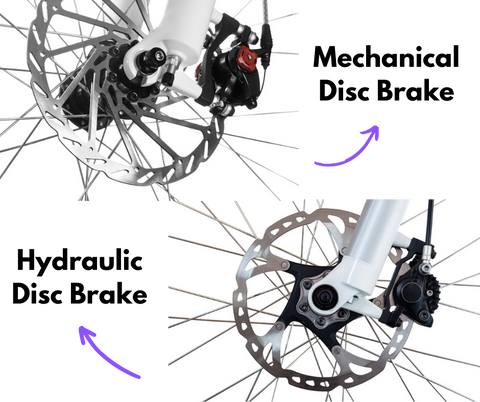The evolution of bicycle brakes over the years has seen a variety of systems designed to improve efficiency, safety, and control under different riding conditions. From the early days of simple rim brakes to the advanced hydraulic systems available today, the development of bicycle brakes has been driven by the need for reliability, ease of maintenance, and performance.
Let's check out the most common types of bicycle brakes, including rim brakes, disc brakes, drum brakes, and coaster brakes.
Rim Brakes
Among the oldest and most common types of bicycle brakes are rim brakes. These systems function by applying friction to the wheel's rim to slow down and stop the bicycle. There are several types of rim brakes:
1.1: Caliper Brakes
Caliper brakes are perhaps the most widely recognized type of rim brake. Mounted to the frame or fork, caliper brakes pivot to bring the brake pads into contact with the sides of the wheel's rim. They are commonly found on road bikes due to their lightweight design and effective stopping power under normal riding conditions.
-
Advantages: One of the main benefits of caliper brakes is their lightweight construction, which makes them a favorite among road cyclists looking to reduce the overall weight of their bicycles. They are also relatively easy to maintain and adjust, making them suitable for beginners and experienced cyclists alike.
-
Disadvantages: Caliper brakes can lose effectiveness in wet or dirty conditions as water and grime decrease the friction between the brake pads and the rim. Additionally, they may not provide enough clearance for wider tires or mudguards, limiting their use to road and racing bikes.
1.2: Cantilever Brakes
Cantilever brakes feature arms that mount to separate brake bosses on each side of the fork (front) or frame (rear). A cable pulls the arms together, pressing the pads against the rim. This design offers powerful braking and is commonly used on cyclocross, touring, and older mountain bikes.
-
Advantages: The strength of cantilever brakes lies in their ability to provide strong braking force, making them ideal for bikes that carry heavy loads or traverse rough terrain. They can also accommodate wider tires, giving versatility for different types of bicycles.
-
Disadvantages: The complexity of setup and adjustment is a notable downside. Achieving optimal performance requires precise alignment and tension adjustment, which can be challenging for those unfamiliar with the system.
1.3: V-Brakes (Linear Pull Brakes)
V-Brakes, also known as linear-pull brakes, are a type of rim brake where the brake arms extend perpendicular to the wheel's rim, and the brake cable pulls directly on the arms, bringing the pads to the rim. They are prevalent on modern mountain bikes, hybrid bikes, and some road bikes.
-
Advantages: V-Brakes have powerful and reliable stopping power, making them suitable for a wide range of bicycles and riding conditions. Their design allows for easy maintenance and pad replacement, and they provide ample clearance for mudguards and wider tires.
-
Disadvantages: A potential drawback is that the long arms of V-Brakes can interfere with mudguards or racks. Additionally, like all rim brakes, their effectiveness can be compromised in wet and muddy conditions.
Disc Brakes
Disc brakes represent a significant advancement in bicycle braking technology, that has consistent stopping power under a wide range of conditions. Unlike rim brakes, which apply pressure to the outer rim of the wheel, disc brakes squeeze a rotor attached to the wheel hub. This system has become increasingly popular across all types of bicycles, including road, mountain, and hybrid bikes, due to its reliability and efficiency. Disc brakes come in two main types: mechanical and hydraulic.
2.1: Mechanical Disc Brakes
These brakes work by using a cable to pull calipers together, which in turn clamps the brake pads onto a disc mounted at the center of the wheel. The mechanical system is simple and robust, making it a popular choice for many cyclists.
-
Advantages: The primary benefit of mechanical disc brakes is their consistent performance in varied weather conditions, including rain and mud, where rim brakes might falter. They are easier to maintain and adjust than hydraulic systems, as they don't require bleeding and can be serviced with basic tools. Mechanical disc brakes also tend to have a longer pad life compared to rim brakes, offering better long-term value and reliability.
-
Disadvantages: While these brakes have many benefits, they are typically heavier than their rim brake counterparts and can be more challenging to set up initially. They may also require more frequent adjustments to maintain optimal performance as the pads wear down.

2.2: Hydraulic Disc Brakes
Hydraulic disc brakes utilize a sealed fluid system to transfer force from the lever to the calipers, pressing the pads against the disc. This system offers a more direct and efficient transfer of energy, resulting in a more superior stopping power and control.
-
Advantages: Hydraulic disc brakes are known for their efficient stopping power and minimal effort required at the lever, which provides a more comfortable and controlled braking experience, especially on long descents or in wet and muddy conditions. The automatic pad wear adjustment is a convenient feature, ensuring consistent braking performance over time without the need for manual adjustment.
-
Disadvantages: The main drawbacks of hydraulic disc brakes include their higher cost compared to mechanical disc and rim brakes, as well as the complexity of maintenance. Servicing hydraulic brakes typically requires specialized tools and knowledge, particularly when it comes to bleeding the system, which can be a deterrent for some DIY cyclists.
Drum Brakes
Drum brakes are a less common but highly durable type of bicycle brake that integrates into the hub of the wheel. This enclosed system is similar to the braking mechanisms found in some automobiles and motorcycles, making it unique.
The mechanism of drum brakes involves brake shoes that sit inside a cylinder-shaped drum. When the brake lever is pulled, the shoes are forced outward against the inner surface of the drum. This action creates the necessary friction to slow down or stop the bicycle. The entire assembly is contained within the wheel hub, protecting it from external elements like dirt, water, and mud, which can affect brake performance.

Advantages
-
Low Maintenance: The enclosed design keeps out contaminants, meaning the brakes rarely need cleaning or adjustment.
-
Weather Resistant: Since they're not exposed to the environment, their performance is not degraded by rain, snow, or mud, making them an excellent choice for all-season cyclists.
-
Durability: The components of drum brakes are robust and wear down very slowly. This makes drum brakes a long-lasting option, ideal for riders who want a "fit and forget" braking system.
Disadvantages
-
Weight: Drum brakes are heavier than most other bicycle brake systems. The additional weight is primarily due to the metal drum and the internal mechanism, which can be a drawback for riders concerned about bike weight.
-
Complexity in Repair: While they require less frequent maintenance, drum brakes are complex and challenging to service when issues do arise. Specialized tools and expertise may be necessary to repair or replace the internal components.
-
Performance Limitations: Although reliable, these brakes typically do not offer the same level of stopping power as disc brakes, especially in high-speed or emergency braking scenarios. This makes them less popular among performance-oriented cyclists.
Coaster Brakes
Coaster brakes stand out for their simplicity and ease of use, making them a favorite for casual riders and a staple on children's bikes, cruisers, and some utility bicycles. Unlike the externally mounted systems like rim, disc, and drum brakes, a coaster brake is integrated into the rear hub and activated by pedaling backward. This intuitive mechanism has its roots in the early days of cycling, yet it remains relevant for its straightforward operation and minimal maintenance requirements.
The operation of a coaster brake is elegantly simple: when the rider pedals backward, an internal brake mechanism within the hub engages, pressing brake shoes against the inside of the hub shell and slowing the bike through friction. This system eliminates the need for cables, levers, or external brake calipers, contributing to a clean and uncluttered bicycle design.
Advantages
-
Simplicity: The lack of external components makes coaster brakes incredibly straightforward to use. There's no need to adjust brake levers or cables, making this system ideal for beginners or those seeking a no-fuss cycling experience.
-
Maintenance: Coaster brakes require very little maintenance. With fewer external parts to adjust or replace, they offer a "set it and forget it" solution for riders not inclined towards regular bike maintenance.
-
Safety in Simplicity: For young riders still mastering the coordination for hand-operated brakes, coaster brakes provide a safe, simple alternative. They allow children to focus on balancing and pedaling without worrying about hand strength or reaction time to engage the brake.
Disadvantages
-
Limited Modulation: Coaster brakes offer less control over braking intensity compared to hand-operated systems. The on/off nature of the braking mechanism makes it harder to apply gentle pressure for gradual slowing, which can be a drawback in traffic or on variable terrain.
-
Rear Wheel Only: Since coaster brakes are integrated into the rear hub, they only provide braking power to the rear wheel. This can limit stopping power, especially in emergency situations or on downhill slopes, where front-wheel braking is more effective.
-
Not Suitable for All Bikes: The design of coaster brakes restricts their use to bicycles with a compatible rear hub. They are not an option for bikes designed for high-performance riding, such as road or mountain bikes, where precise braking control and distribution are critical.

Choosing the right type of brake depends on your needs, riding conditions, and personal preferences. As technology advances, we have more options for customization and performance, ensuring safety and enjoyment on our rides.
To check out more, visit BikeBerry.com.








